
Wine Culture and Information since 2002 - Volume 22
 Wine Culture and Information since 2002 - Volume 22 |
|
Comparing AmaroneRich, powerful and concentrated however smooth and elegant, the great wine from Valpolicella is since many years one of the indisputable protagonists of Italian enology in the world |
|
You say Amarone della Valpolicella and you think about a great wine, an important wine rich of charm and elegance, powerful nevertheless gentle in its velvety roundness. Now considered a cult wine, Amarone della Valpolicella - or simply Amarone - belongs since many years to the category of the so called important wines, one of those wines having countless lovers around the world, looked for and appreciated everywhere. The secret of the success of Amarone - besides the irreplaceable role of Valpolicella, the grapes with which it is made from and the particular vinification technique - certainly is represented by its organoleptic qualities, a robust and powerful wine, however with an unique class and elegance, smooth enough, impetuous and powerful enough. Amarone della Valpolicella is an amazing sensorial discovery according to every aspect: intense in colors, most of the times impenetrable to light, an explosion of aromas and flavors that with time get a remarkable complexity. The “discovery” of Amarone is pretty recent, as it is a derivation of the traditional Recioto della Valpolicella. If it is true the history of Recioto della Valpolicella is many centuries long, the history of Amarone della Valpolicella is more recent. Recioto, as it is commonly known, is a sweet wine produced with dried grapes. In Valpolicella it is said Amarone is just a Recioto scapà, that is scappato (Italian for fled away) from the control of the maker and therefore completes fermentation, with the result of obtaining a dry wine - that is amaro (Italian for bitter) - with no hint of sweetness. No sweetness, but a lot of roundness which is added to the exuberance of tannins and the remarkable structure: a wine which hardly goes unnoticed when it is poured in the glass. With time Amarome has surpassed Recioto, probably because of the change of taste in our times, therefore becoming today the most representative and famous wine of Valpolicella.
|
|
Amarone della Valpolicella is mainly produced with Corvina, Rondinella and Molinara grapes - to which it is frequently added Corvinone - properly dried and then vinified. According to the production disciplinary, Amarone must age for at least two years, although most of the times producers allow their wines to age for a longer time. The main grape of Amarone della Valpolicella certainly is Corvina, responsible for the thickness and the remarkable structure of the wine, also accentuated by the concentration obtained by withering the grapes. The other “official” grapes of Amarone are Rondinella and Molinara, although they participate in the composition of the wine in a relatively marginal way, while leaving the part of the protagonist to the robust Corvina which can also represent 70% of the composition. An important role is also played by Corvinone, which is currently subject of the revision of the present production disciplinary, in which producers are asking for the official use of Corvinone and the elimination of the obligatory use of Rondinella and Molinara.
The goal of our comparative tasting is to understand the organoleptic qualities of Amarone and the three selected wines, and according to a productive and enological point of view, they can be considered “similar”. The three Amarone wines selected for our comparative tasting - despite each of them has an absolutely personal character - are mainly produced with the same grapes and all the three are aged for many months in cask. The first wine of our tasting is Ca' Rugate's Amarone della Valpolicella, produced with Corvina, Corvinone and Rondinella grapes, aged in cask for about 30 months. The second wine is Allegrini's Amarone della Valpolicella Classico, produced with the classic “recipe” of Corvina, Rondinella and Molinara, aged in cask for 19 months. The third wine of our comparative tasting is Masi's Amarone della Valpolicella Classico Campolongo di Torbe, also in this case produced with Corvina, Rondinella and Molinara, aged in cask for 3 years. The three wines will be served at a temperature of 18° C (65° F) and for the sensorial evaluation will be used, as usual, three ISO tasting glasses.
|
||||||||
|
Amarone della Valpolicella is a complex wine, rich and intense not only in aromas and flavors, but also in colors. The production of Amarone makes use of dried grapes and the withering process, besides concentrating the juice, concentrates the color as well. For this reason, Amarone della Valpolicella is generally characterized by pretty deep and dark colors in which can be observed an intense ruby red, frequently garnet red, the latter being also visible in nuances. The transparency of Amarone della Valpolicella is pretty low, most of the times impenetrable to light, another quality derived from the concentration of the must and the subsequent maceration with the skins during fermentation. With time, the transparency of Amarone will continue to be low, despite it can be observed evident sediments on the bottom of the bottle, and the color will get evident garnet red hues and brick red nuances. The first wine of which we will examine appearance is Ca' Rugate's Amarone della Valpolicella. By holding the glass titled over a white surface - a clean sheet of paper is enough - we will examine the color at the base of the liquid mass. We will notice an intense ruby red color and a pretty low transparency, almost impenetrable to light. By observing the edge of the wine, towards the opening of the glass, we will notice garnet red nuances. Let's now pass to the evaluation of the second wine's appearance: Allegrini's Amarone della Valpolicella Classico. By holding the glass tilted, we will notice an intense ruby red color, however deeper than the previous wine, and garnet red nuances. The transparency of this Amarone is lower than the previous wine, in this case no passage of light is being observed. The aspect of the last wine - Masi's Amarone della Valpolicella Classico Campolongo di Torbe - is not different from the previous wines. Its color is in fact deep ruby red with garnet red nuances, and the transparency is very low, almost impenetrable to light.
|
|
The olfactory profile of Amarone della Valpolicella is, to the nose of the taster, a very rich and formative experience. In this wine are in fact found aromas belonging to different families, from flowers and fruits aromas, to empyreumatic and balsamic aromas. As Amarone can stand to a long period of aging in bottle - thanks to polyphenols and alcohol it can also age for some tens of years - with time aromas develop extremely complex qualities. Among the primary aromatic qualities of Amarone are certainly noticed the ones of flowers and fruits. Violet and rose are the most typical flower aromas of Amarone, whereas in the realm of fruit are mainly found blackberry, black cherry and plum, also in the form of jams. Balsamic aromas are also frequent, in particular the ones of menthol and eucalyptus. Among the complex aromas usually found in Amarone are frequent the ones of vanilla, chocolate and cocoa, whereas with a proper period of aging, will also develop more complex aromas of tobacco, licorice, leather, cinnamon, clover, black pepper, mace and rhubarb. As usual, the olfactory evaluation of the wines will be divided into two distinct phases: in the first phase we will evaluate opening aromas, that is the aromas requiring a small quantity of oxygen in order to volatilize, whereas in the second phase will be evaluated all the other aromas, that is the ones made of “heavier” molecules requiring a higher quantity of oxygen in order to volatilize. We will begin the evaluation of the aromas from Ca' Rugate's Amarone della Valpolicella. By holding the glass in vertical position and without swirling, we will proceed with the first smell. From the glass will be perceived aromas of blackberry, black cherry and plum, the typical opening of Amarone della Valpolicella. After having swirled the glass, we will proceed with the second smell allowing the perception of a pretty rich aromatic profile, in which will be recognized the aromas of violet, blueberry, vanilla, licorice, cinnamon, tobacco, chocolate, mace, pink pepper and menthol, as well as a pleasing hint of nail polish. Let's now pass to the evaluation of Allegrini's Amarone della Valpolicella Classico. By holding the glass in vertical position and without swirling, we will proceed with the first smell in order to evaluate opening aromas. From the glass will be perceived intense and clean aromas of blackberry jam, black cherry jam and plum, also in this case a typical opening of Amarone, even though - as opposed to the previous wine - from the glass will develop more “mature” aromas. The second smell, after having swirled the glass, will complete the olfactory profile of the wine with aromas of dried violet, blueberry, licorice, vanilla, tobacco, cinnamon and cocoa, as well as pleasing hints of cinchona and nail polish. Also the opening of the last wine - Masi's Amarone della Valpolicella Classico Campolongo di Torbe - has a very typical opening: blackberry, black cherry and plum. The second smell, after having swirled the glass, will allow the perception of dried violet, blueberry, licorice, tobacco, vanilla, pink pepper, cocoa, cinnamon and mace, as well as a pleasing aroma of nail polish and the more complex aroma of leather.
|
||||
|
According to a gustatory point of view, Amarone della Valpolicella is a pretty rich and thick wine, with an evident astringency, however balanced both by the evident roundness as well as by the remarkable alcohol by volume. Also acidity - although it is pretty “covered” by roundness and alcohol - is pleasingly perceivable in Amarone della Valpolicella, therefore contributing to harmony and balance. The attack of Amarone is typically astringent and alcoholic, to which is added the evident sensation of full body, evidently robust. The structure of Amarone is of course determined also by the type of cask used for the aging and its volume. As it is a wine produced with dried grapes, alcohol by volume in Amarone is considerable, with an average value of 14.5% and it is not infrequent to find wines with a higher quantity of alcohol. However, the presence of alcohol contributes to mitigate the effect of astringency and to make the wine rounder and smoother, a quality making Amarone particularly agreeable. The first wine of which we will examine gustatory qualities is Ca' Rugate's Amarone della Valpolicella. The attack of this Amarone is tannic and it can be noticed the robust structure, followed by the pseudo-caloric sensation of alcohol. It should noticed the excellent correspondence to the nose, in particular the flavor of blackberry. Moreover, it should be noticed the pleasing roundness, a typical quality of Amarone and fundamental - together with alcohol - to the balance of tannins. Let's now pass to the second wine: Allegrini's Amarone della Valpolicella Classico. Once again, the attack is tannic, however with a less aggressive astringency than the previous Amarone, with more “mature” tannins balanced both by alcohol and roundness. Also the attack of the last wine - Masi's Amarone della Valpolicella Classico Campolongo di Torbe - is tannic, showing since the first sip a remarkable structure. Also in this case, the balance is excellently obtained both by alcohol and roundness, with “smooth” tannins and pleasing to the taste. Finally, it should be noticed the excellent correspondence to the nose of the three wines, in particular the flavors of blackberry and plum.
|
|
Thanks to the particular production technique, in which are being used dried grapes, a process favoring the concentration of the juice and its organoleptic qualities, Amarone is generally characterized by very long taste-olfactory persistence, such as in the case of the wines of our comparative tasting. The finish of Ca' Rugate's Amarone della Valpolicella is very persistent, leaving in the mouth clean flavors of blackberry, black cherry and plum: a typical finish of Amarone. A similar finish - very persistent and clean - is also perceived in Allegrini's Amarone della Valpolicella Classico, with intense flavors of blackberry, black cherry and plum. Another confirmation is offered by Masi's Amarone della Valpolicella Classico Campolongo di Torbe: very long persistence and clean flavors of blackberry, black cherry and plum. In the final phases of the tasting, it is also interesting to notice the influence of the different time of aging in cask on taste, in all the three cases very balanced and never intrusive.
|
Wines of the Month |
|
|
|
Score legend Prices are to be considered as indicative. Prices may vary according to the country or the shop where wines are bought |

|
|
Voira 2005 |
|
| Cantine Cipressi (Molise, Italy) | |
| Grapes: Chardonnay (75%), Trebbiano Toscano (15%) | |
| Price: € 7.50 | Score: |
| Voira shows an intense straw yellow color and nuances of straw yellow, very transparent. The nose denotes intense, clean, pleasing and refined aromas that start with hints of apple, plum and almond followed by aromas of hawthorn, medlar, pear and grapefruit. The mouth has good correspondence to the nose, a crisp attack and pleasing roundness, however balanced by alcohol, good body, intense flavors. The finish is persistent with flavors of plum, apple and almond. Voira ages for few months in barrique. | |
| Food Match: Mushrooms soups, Pasta and risotto with vegetables and fish, Sauteed fish | |
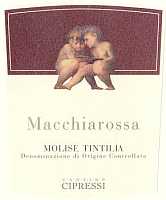
|
|
Molise Tintilia Macchiarossa 2004 |
|
| Cantine Cipressi (Molise, Italy) | |
| Grapes: Tintilia | |
| Price: € 16.00 | Score: |
| Molise Tintilia Macchiarossa shows a brilliant ruby red color and nuances of garnet red, little transparency. The nose denotes intense, clean, pleasing and refined aromas which start with hints of black cherry and plum followed by aromas of blueberry, blackberry, cyclamen, violet, black pepper, vanilla and carob. The mouth has good correspondence to the nose, a tannic attack and pleasing roundness, however balanced by alcohol, good body, intense flavors. The finish is persistent with flavors of black cherry and plum. Molise Tintilia Macchiarossa ages for about 12 months in cask. | |
| Food Match: Roasted meat, Stewed and braised meat, Hard cheese | |
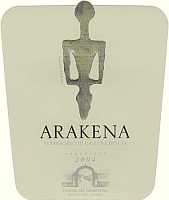
|
|
Vermentino di Gallura Superiore Arakena 2005 |
|
| Cantina del Vermentino (Sardinia, Italy) | |
| Grapes: Vermentino | |
| Price: € 18.00 | Score: |
| Vermentino di Gallura Superiore Arakena shows a pale straw yellow color and nuances of greenish yellow, very transparent. The nose reveals intense, clean, pleasing and refined aromas that start with hints of pear, apple and pineapple followed by aromas of almond, hawthorn, peach, broom, rosemary, plum and vanilla. The mouth has good correspondence to the nose, a crisp attack and however balanced by alcohol, good body, intense flavors. The finish is persistent with flavors of apple, plum and pineapple. This wine ferments in cask. | |
| Food Match: Pasta and risotto with fish and crustaceans, Broiled fish, Stewed fish | |
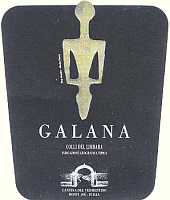
|
|
Galana 2000 |
|
| Cantina del Vermentino (Sardinia, Italy) | |
| Grapes: Cabernet Sauvignon (20%), Sangiovese (20%), Carignano (20%), Cagnulari (20%), Bovale (20%) | |
| Price: € 18.00 | Score: |
| Galana shows a brilliant ruby red color and nuances of garnet red, moderate transparency. The nose denotes intense, clean, pleasing and refined aromas that start with hints of black cherry, plum and geranium followed by aromas of raspberry, violet, vanilla, tobacco, pink pepper, menthol and cinnamon. The mouth has good correspondence to the nose, a tannic attack and pleasing roundness, however balanced by alcohol, good body, intense flavors. The finish is persistent with flavors of black cherry, plum and raspberry. Galana ages for 13 months in cask followed by at least 10-15 months of aging in bottle. | |
| Food Match: Roasted meat, Stewed and braised meat, Hard cheese | |
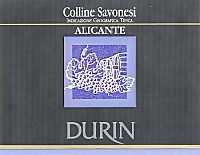
|
|
Alicante 2004 |
|
| Durin (Liguria, Italy) | |
| Grapes: Alicante | |
| Price: € 13.50 | Score: |
| This Alicante shows an intense ruby red color and nuances of ruby red, little transparency. The nose denotes intense,clean, pleasing and refined aromas that start with hints of black cherry and plum followed by aromas of rose, blackberry, vanilla, carob and menthol. The mouth has good correspondence to the nose, a tannic attack and however balanced by alcohol, good body, intense flavors. The finish is persistent with flavors of black cherry and plum. This wine ages for 10-12 months in barrique followed by 6 months of aging in bottle. | |
| Food Match: Roasted meat, Stewed meat, Hard cheese | |
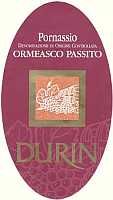
|
|
Pornassio Ormeasco Passito 2005 |
|
| Durin (Liguria, Italy) | |
| Grapes: Ormeasco | |
| Price: € 15.00 - 0.375l | Score: |
| The wine shows a brilliant ruby red color and nuances of garnet red, moderate transparency. The nose denotes intense, clean, pleasing and refined aromas that start with hints of strawberry, cherry and raspberry followed by aromas of rose, plum, dried violet, vanilla and cinnamon. The mouth has good correspondence to the nose, a sweet and slightly tannic attack, however balanced by alcohol, good body, intense flavors, agreeable. The finish is persistent with flavors of strawberry, cherry and plum. Pornassio Ormeasco Passito ages in small oak barrels. | |
| Food Match: Fruit tarts, Confectionery | |
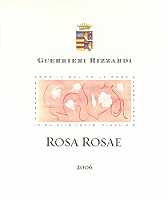
|
|
Rosa Rosae 2006 |
|
| Guerrieri Rizzardi (Veneto, Italy) | |
| Grapes: Corvina (65%), Rondinella (20%), Sangiovese (10%), Marcobona (5%) | |
| Price: € 9.80 | Score: |
| Rosa Rosae shows a brilliant onion skin pink color and nuances of pale pink, transparent. The nose reveals intense, clean, pleasing and refined aromas that start with hints of cherry, raspberry and strawberry followed by aromas of cyclamen, peach, rose and plum. The mouth has good correspondence to the nose, a crisp attack and however balanced by alcohol, good body, intense flavors. The finish is persistent with flavors of cherry, raspberry and strawberry. Rosa Rosae ages for 3 months in steel and cement tanks. | |
| Food Match: Stuffed pasta, Roasted fish, Fish soups, Sauteed white meat | |
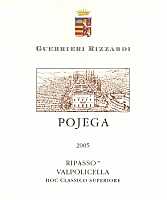
|
|
Valpolicella Classico Superiore Ripasso Pojega 2005 |
|
| Guerrieri Rizzardi (Veneto, Italy) | |
| Grapes: Corvina, Corvinone (85%), Rindonella, Molinara (15%) | |
| Price: € 9.80 | Score: |
| This wine shows a brilliant ruby red color and nuances of ruby red, moderate transparency. The nose denotes intense, clean, pleasing and refined aromas that start with hints of plum, black cherry and blackberry followed by aromas of raspberry, violet, vanilla and pink pepper. The mouth has good correspondence to the nose, a tannic attack and however balanced by alcohol, good body, intense flavors. The finish is persistent with flavors of black cherry and plum. Valpolicella Classico Superiore Ripasso Pojega ages for at least 12 months in cask. | |
| Food Match: Roasted meat, Stewed and braised meat, Hard cheese | |
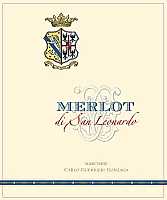
|
|
Merlot di San Leonardo 2004 |
|
| Tenuta San Leonardo (Trentino, Italy) | |
| Grapes: Merlot | |
| Price: € 14.00 | Score: |
| Merlot di San Leonardo shows an intense ruby red color and nuances of garnet red, little transparency. The nose denotes intense, clean, pleasing and refined aromas which start with hints of black cherry, plum and black currant followed by aromas of blueberry, mace, vanilla and eucalyptus. The mouth has good correspondence to the nose, a slightly tannic attack and pleasing roundness, however balanced by alcohol, good body, intense flavors. The finish is persistent with flavors of black cherry, plum and black currant. This Merlot ages for 18 months in cask followed by at least 4 months of aging in bottle. | |
| Food Match: Stuffed pasta, Sauteed meat with mushrooms, Broiled meat and barbecue | |
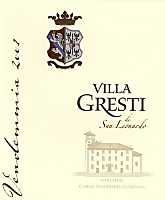
|
|
Villa Gresti 2003 |
|
| Tenuta San Leonardo (Trentino, Italy) | |
| Grapes: Merlot (90%), Carmenère (10%) | |
| Price: € 33.00 | Score: |
| Villa Gresti shows an intense ruby red color and nuances of garnet red, little transparency. The nose reveals intense, clean, pleasing, refined and elegant aromas which start with hints of black currant, plum and black cherry followed by aromas of blueberry, vanilla, chocolate, greenbeans, bell pepper, licorice, tobacco, chocolate, pink pepper and eucalyptus. The mouth has excellent correspondence to the nose, a tannic attack and pleasing roundness, however well balanced by alcohol, full body, intense flavors. The finish is very persistent with long flavors of black cherry, black currant and black cherry. A well made wine. Villa Gresti ages for 12-14 months in barrique followed by 12 months of aging in bottle. | |
| Food Match: Game, Roasted meat, Stewed and braised meat, Hard cheese | |
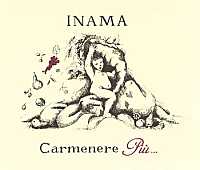
|
|
Carmenere Più 2005 |
|
| Inama (Veneto, Italy) | |
| Grapes: Carmenère (60%), Merlot (30%), Raboso Veronese (10%) | |
| Price: € 13.00 | Score: |
| Carmenere Più shows an intense ruby red color and nuances of ruby red, little transparency. The nose reveals intense, clean, pleasing and refined aromas which start with hints of black cherry, plum and black currant followed by aromas of blueberry, bell pepper, vanilla, violet, cocoa and menthol. The mouth has good correspondence to the nose, a tannic attack and however balanced by alcohol, good body, intense flavors. The finish is persistent with flavors of black cherry, plum and black currant. Carmenere Più ages for 12 months in barrique. | |
| Food Match: Roasted meat, Broiled meat and barbecue, Stewed meat | |
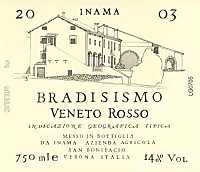
|
|
Bradisismo 2003 |
|
| Inama (Veneto, Italy) | |
| Grapes: Cabernet Sauvignon (70%), Carmenère (20%), Merlot (10%) | |
| Price: € 28.00 | Score: |
| Bradisismo shows a deep ruby red color and nuances of garnet red, little transparency. The nose reveals intense, clean, pleasing, refined and elegant aromas that start with hints of black cherry, plum and black currant followed by aromas of blackberry, violet, bell pepper, tobacco, licorice, cocoa, cinnamon, mace and eucalyptus. The mouth has excellent correspondence to the nose, a tannic attack and however balanced by alcohol, full body, intense flavors, pleasing roundness. The finish is very persistent with long flavors of black currant, black cherry and plum. A well made wine. Bradisismo ages for 15 months in barrique. | |
| Food Match: Game, Roasted meat, Braised and stewed meat, Hard cheese | |
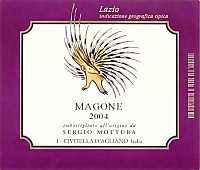
|
|
Magone 2004 |
|
| Sergio Mottura (Latium, Italy) | |
| Grapes: Pinot Noir | |
| Price: € 18.00 | Score: |
| Magone shows an intense ruby red color and nuances of ruby red, moderate transparency. The nose denotes intense, clean and pleasing aromas that start with hints of cherry and plum followed by aromas of raspberry, blueberry, cyclamen and cinnamon. The mouth has good correspondence to the nose, a slightly tannic attack and however balanced by alcohol, good body, intense flavors. The finish is persistent with flavors of plum and cherry. Magone ages for 12 months in cask followed by 6 months of aging in bottle. | |
| Food Match: Stuffed pasta, Stewed meat, Roasted meat | |
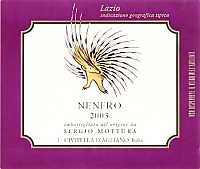
|
|
Nenfro 2003 |
|
| Sergio Mottura (Latium, Italy) | |
| Grapes: Merlot (60%), Montepulciano (40%) | |
| Price: € 16.70 | Score: |
| Nenfro shows a brilliant ruby red color and nuances of garnet red, little transparency. The nose reveals intense, clean, pleasing and refined aromas that start with hints of black cherry, plum and black currant followed by aromas of blueberry, violet, vanilla, tobacco, chocolate and mace. The mouth has good correspondence to the nose, a tannic attack and however balance by alcohol, good body, intense flavors, pleasing roundness. The finish is persistent with flavors of black cherry and plum. Nenfro ages for 12 months in barrique followed by 12 months of aging in bottle. | |
| Food Match: Roasted meat, Stewed and braised meat, Hard cheese | |
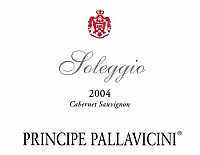
|
|
Soleggio 2004 |
|
| Principe Pallavicini (Latium, Italy) | |
| Grapes: Cabernet Sauvignon | |
| Price: € 10.80 | Score: |
| Soleggio shows an intense ruby red color and nuances of ruby red, little transparency. The nose reveals intense, clean, pleasing and refined aromas which start with hints of black cherry and blueberry followed by aromas of black currant, plum, violet, vanilla and carob. The mouth has good correspondence to the nose, a tannic attack and however balanced by alcohol, good body, intense flavors. The finish is persistent with flavors of black cherry and blueberry. Soleggio ages for 12 months in barrique. | |
| Food Match: Stewed meat with mushrooms, Broiled meat and barbecue, Roasted meat | |

|
|
Moroello 2004 |
|
| Principe Pallavicini (Latium, Italy) | |
| Grapes: Sangiovese Grosso, Merlot | |
| Price: € 19.80 | Score: |
| This wine shows an intense ruby red color and nuances of ruby red, little transparency. The nose denotes intense, clean, pleasing and refined aromas that start with hints of black cherry, plum and black currant followed by aromas of blueberry, cinnamon, bell pepper, violet, tobacco, vanilla, chocolate and menthol. The mouth has good correspondence to the nose, a tannic attack and however balanced by alcohol, good body, intense flavors. The finish is persistent with flavors of black cherry, plum and black currant. Moroello ages in cask. | |
| Food Match: Roasted meat, Braised and stewed meat, Hard cheese | |
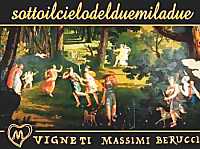
|
|
Sottoilcielodelduemiladue 2002 |
|
| Vigneti Massimi Berucci (Latium, Italy) | |
| Grapes: Cesanese d'Affile (70%), Aglianico (30%) | |
| Price: € 10.60 | Score: |
| This wine shows an intense ruby red color and nuances of garnet red, little transparency. The nose denotes intense, clean, pleasing and refined aromas that start with hints of plum and blueberry followed by aromas of black cherry, dried violet, vanilla, tobacco, carob and menthol. The mouth has good correspondence to the nose, a tannic attack and however balanced by alcohol, good body, intense flavors. The finish is persistent with flavors of black cherry and plum. This wine ages in cask. | |
| Food Match: Cold cuts, Stewed meat with mushrooms, Roasted meat | |

|
|
Cesanese del Piglio Vigne Nuove 2003 |
|
| Vigneti Massimi Berucci (Latium, Italy) | |
| Grapes: Cesanese d'Affile | |
| Price: € 18.00 | Score: |
| Cesanese del Piglio Vigne Nuove shows an intense ruby red color and nuances of garnet red, little transparency. The nose reveals intense, clean, pleasing and refined aromas that start with hints of black cherry and blueberry followed by aromas of blackberry, plum, violet, vanilla, tobacco, cinnamon and carob. The mouth has good correspondence to the nose, a tannic attack and pleasing roundness, however balanced by alcohol, good body, intense flavors. The finish is persistent with flavors of blueberry and plum. Cesanese del Piglio Vigne Nuove ages in cask for 12 months followed by 8 months of aging in bottle. | |
| Food Match: Roasted meat, Stewed and braised meat, Hard cheese | |
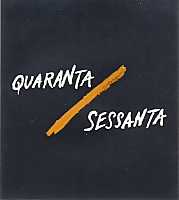
|
|
Quaranta/Sessanta 2005 |
|
| L'Olivella (Latium, Italy) | |
| Grapes: Syrah (40%), Cesanese (60%) | |
| Price: € 6.90 | Score: |
| The wine shows a brilliant ruby red color and nuances of ruby red, moderate transparency. The nose denotes intense, clean and pleasing aromas which start with hints of black cherry, plum and blackberry followed by aromas of raspberry, strawberry, black pepper and violet. The mouth has good correspondence to the nose, a tannic attack and however balanced by alcohol, good body, intense flavors. The finish is persistent with flavors of black cherry and plum. | |
| Food Match: Stuffed pasta with meat, Stewed meat, Broiled meat and barbecue | |
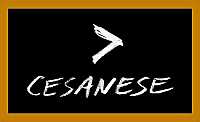
|
|
Cesanese Maggiore 2003 |
|
| L'Olivella (Latium, Italy) | |
| Grapes: Cesanese | |
| Price: € 16.20 | Score: |
| Cesanese Maggiore shows an intense ruby red color and nuances of garnet red, little transparency. The nose denotes intense, clean, pleasing and refined aromas that start with hints of black cherry, plum and blueberry followed by aromas of violet, tobacco, vanilla, licorice, chocolate, mace and menthol. The mouth has good correspondence to the nose, a tannic attack and however balanced by alcohol, good body, intense flavors, pleasing roundness. The finish is persistent with flavors of black cherry, plum and blueberry. Cesanese Maggiore ages for 12 months in cask. | |
| Food Match: Roasted meat, Stewed meat with mushrooms, Hard cheese | |
|
||||||||
|
DiWineTaste Polls
|
| |||||||
Privacy Policy | |||||||


| Copyright © 2002-2024 Antonello Biancalana, DiWineTaste - All rights reserved |
| All rights reserved under international copyright conventions. No part of this publication and of this WEB site may be
reproduced or utilized in any form or by any means, electronic or mechanical, without permission in writing from DiWineTaste. |